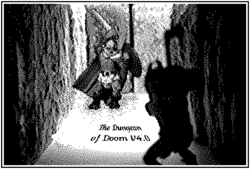- The Dungeon Revealed
-
The Dungeon of Doom /
The Dungeon Revealed
Developer(s) John Raymonds Publisher(s) Woodrose Editions Platform(s) Mac OS Release date(s) 1985–1987 Genre(s) Roguelike dungeon crawl Mode(s) Single player The Dungeon Revealed is a popular dungeon crawl computer game created by John Raymonds and published by Woodrose Editions in 1987. A demo and shareware version of the game entitled The Dungeon of Doom were released in 1986 and 1987 respectively to promote the commercial release of "The Dungeon Revealed" which came in 1987. Both were released for Mac OS, and were compatible with versions as late as System 7. In fact, The "Dungeon Revealed" can still be played with Mac OS 10.4.10 in Classic (Mac OS 9.2.2) but suffers from an absence of sound. "The Dungeon of Doom", the demo and shareware releases, were not 32-bit clean and thus not compatible with Mac OS 7.5 and up.
Contents
Objective
The player controls a single character trapped in an underground dungeon. If the character attempts to take the stairs from the dungeon, a message appears: "A force prevents you from escaping to the surface. Maybe the Orb will set you free..."
Like this first message, much of the game's story and mechanics are vague or completely undocumented. Most of the player's information comes from a window called Rumors, which contains 26 short, cryptic statements including
- "Death is only a word"
- "The Dark Wizard guards the orb"
- "The 40th level is death"
- "Experience strikes twice"
- "There are two orbs"
- "Beauty can tame a beast"
The dungeon is divided into 40 floors, each with one staircase going up, and one going down. The floor plan of each level is randomly generated, but remains unchanged throughout a single game. Though each level is about the same size, the complexity of the floor plans becomes more maze-like as the character descends to deeper dungeon levels. There are also items, including weapons, armor, magical rings, scrolls, potions, wands, food items, and jewels placed randomly throughout the dungeon's floors.
Progress though the dungeon is hindered by monsters who, depending on the circumstances, have varying levels of hostility towards the character. The character must also eat periodically to avoid starvation. The monsters become more powerful and resistant to attack as the player progresses deeper into the dungeon.
Characters
The player begins the game by creating a new character from one of seven classes: knight, fighter, sage, wizard, alchemist, jeweler, and jones. Each class has a different set of attributes, parameterized similarly to Dungeons & Dragons. Each attribute affects the character's abilities in a number of ways, many of which are undocumented. Characters with a high intelligence attribute, for example, have a higher probability of success when casting magic spells from a scroll, as well as an improved ability to map the dungeon. In addition, each class has an increased likelihood of being able to identify a certain type of item. Characters can improve their ability scores throughout the game, both temporarily and permanently, through the use of potions and scrolls.
Each class, with the exception of "Jones", also has the unique ability to assess one type of object. Alchemists, for example, can accurately identify the potions they find in the dungeon, and therefore avoid drinking those with harmful effects, wizards wield wands more effectively, and so forth. All classes can reach the highest levels in each ability by obtaining a variety of scrolls and potions that raise strength, intelligence, wisdom, dexterity, constitution, and charisma. Strength controls a character's ability to attack, intelligence and wisdom, the ability to read and understand scrolls successfully, dexterity, the ability to wield weapons and throw objects, constitution the ability to withstand attack, and charisma, the ability to increase the odds a defeated monster will leave behind a useful item.
The main objective of the game is to retrieve the orb of Carnos, located on the 40th level and guarded by a powerful boss monster called "The Dark Wizard". The 40th level also contains an ersatz orb, made of plastic, which can only be identified using an "identify scroll".
Version and license history
- The Dungeon of Doom v4.0 (1986) – final shareware release, $25 registration.
- The Dungeon of Doom v5.4 (1987) – free, complete-game demo for The Dungeon Revealed. Identical to version 4.0.
- The Dungeon Revealed v1.0 (1987) – commercial release, sold for $37.50. New features include improved sound effects, new monsters, improved inventory management, and QuickDraw mode (allowing play in a moveable window).
Credits
- John Raymonds – Program Creator
- John Morgan – Monster Designer
- Dan Ferguson – Screen Art
- David Russo
External links
- Dungeon of Doom, a fanpage
Categories:- 1985 video games
- Roguelikes
- Mac OS-only games
Wikimedia Foundation. 2010.

